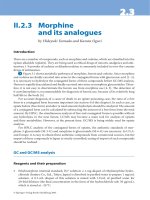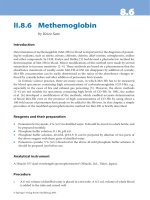Handbook of Risk Theory Epistemology, Decision Theory, Ethics, and Social Implications of Risk doc
Bạn đang xem bản rút gọn của tài liệu. Xem và tải ngay bản đầy đủ của tài liệu tại đây (9.75 MB, 1,202 trang )
Handbook of Risk Theory
Sabine Roeser, Rafaela Hillerbrand, Per Sandin,
Martin Peterson (Eds.)
Handbook of Risk Theory
Epistemology, Decision Theory,
Ethics, and Social Implications of Risk
With 85 Figures and 62 Tables
Editors
Sabine Roeser (Editor-in-Chief)
Philosophy Department
Faculty of Technology, Policy and Management
Delft University of Technology
Delft
The Netherlands
and
Philosophy Department
University of Twente
Enschede
The Netherlands
Rafaela Hillerbrand
Human Technology Center
RWTH Aachen University
Aachen
Germany
Per Sandin
Department of Plant Physiology and Forest Genetics
Swedish University of Agricultural Sciences
Uppsala
Sweden
Martin Peterson
Section for Philosophy and Ethics
Eindhoven University of Technology
Eindhoven
The Netherlands
ISBN 978-94-007-1432-8 e-ISBN 978-94-007-1433-5
Print and electronic bundle under ISBN 978-94-007-1434-2
DOI 10.1007/978-94-007-1433-5
Springer Dordrecht Heidelberg London New York
Library of Congress Control Number: 2011941145
© Springer ScienceþBusiness Media B.V. 2012
No part of this work may be reproduced, stored in a retrieval system, or transmitted in any form or by any means,
electronic, mechanical, photocopying, microfilming, recording or otherwise, without written permission from
the Publisher, with the exception of any material supplied specifically for the purpose of being entered and
executed on a computer system, for exclusive use by the purchaser of the work.
Printed on acid-free paper
Springer is part of Springer ScienceþBusiness Media (www.springer.com)
Preface
Risk has become one of the main topics in fields as diverse as engineering, medicine, and
economics, and it is also studied by social scientists, psychologists, and legal scholars. But the
topic of risk also leads to more fundamental questions such as: What is risk? What can decision
theory contribute to the analysis of risk? What does the human perception of risk mean for
society? How should we judge whether a risk is morally acceptable or not? Over the last couple
of decades, questions like these have attracted interest from philosophers and other scholars
into risk theory.
This handbook provides an overview into key topics in a major new field of research. It
addresses a wide range of topics, from decision theory, risk perception, to ethics and social
implications of risk, and it also addresses specific case studies. It aims to promote communi-
cation and information among all those who are interested in theoretical issues concerning risk
and uncertainty.
This handbook brings together leading philosophers and scholars from other disciplines
who work on risk theory. The contributions are accessibly written and highly relevant to issues
that are studied by risk scholars. We hope that the Handbook of Risk Theory will be a helpful
starting point for all risk scholars who are interested in broadening and deepening their current
perspectives.
The editors:
Sabine Roeser (Editor-in-Chief), Rafaela Hillerbrand, Per Sandin, and Martin Peterson
Sabine Roeser’s work for the Handbook of Risk Theor y has been conducted at the philosophy
departments of TU Delft and Twente University and was sponsored by the Netherlands
Organization for Scientific Research (NWO), with VIDI-grant number 276-20-012.
Rafaela Hillerbrand’s work on this volume was supported by the excellence initiative of
the German federal and state governments and conducted at the Human Technology Centre
(HumTec) and the Institute of Philosophy, RWTH Aachen University. Thanks to all members
of the research group eet - ethics for energy technology for insights into risks from various
disciplines. Special thanks to Andreas Pfennig, Nick Shackel, and Peter Taylor for numerous
fruitful discussions on the topic.
Per Sandin’s work for this handbook was done in the Department of Plant Physiology and
Forest Genetics, Swedish University of Agricultural Sciences, Uppsala and in the Department of
Philosophy and History of Technology, Royal Institute of Technology, Stockholm.
Martin Peterson has conducted his work for the handbook at the philosophy department of
TU Eindhoven. Sabine Roeser and Martin Peterson are members of the 3TU. Centre for Ethics
and Technology, a center of excellence of the federation of the three technical universities in the
Netherlands (Delft, Eindhoven, and Twente).
We are very grateful to the contributors of this handbook. In addition, we would like to
thank Katie Steele, Linda Soneryd, and Misse Wester, each of whom provided expert reviews for
a chapter. We would like to thank the staff at Springer for the excellent collaboration, specially
Ties Nijssen, Jutta Jaeger-Hamers, and Christine Hausmann.
Preface . v
Acknowledgments . . . vii
Editors . xiii
List of Contributors . . . xv
Volume 1
1 Introduction to Risk Theory 1
Sabine Roeser
.
Rafaela Hillerbrand
.
Per Sandin
.
Martin Peterson
Part 1 General Issues in Risk Theory
2 A Panorama of the Philosophy of Risk . . . 27
Sven Ove Hansson
3 The Concepts of Risk and Safety . 55
Niklas Mo
¨
ller
4 Levels of Uncertainty . . . 87
Hauke Riesch
Part 2 Specific Risks
5 The Economics of Risk: A (Partial) Survey 113
Louis Eeckhoudt
.
Henri Louberge
´
6 Interpretation of Forensic Evidence 135
Reinoud D. Stoel
.
Marjan Sjerps
7 Risks and Scientific Responsibilities in Nanotechnology . 159
John Weckert
8 Risk and Risk-Benefit Evaluations in Biomedical Research 179
Annette Rid
9 Understanding and Governing Public Health Risks by Modeling . 213
Erika Mansnerus
10 Management of the Risks of Transport . . . 239
John Adams
11 Risk and Spatial Planning . 265
Claudia Basta
12 Intergenerational Risks of Nuclear Energy . 295
Behnam Taebi
13 Climate Change as Risk? . . 319
Rafaela Hillerbrand
14 Earthquakes and Volcanoes: Risk from Geophysical Hazards 341
Amy Donovan
Part 3 Decision Theory and Risk
15 A Rational Approach to Risk? Bayesian Decision Theory . 375
Claus Beisbart
16 A Philosophical Assessment of Decision Theory . 405
Karsten Klint Jensen
17 The Mismeasure of Risk . . . 441
Peter R. Taylor
18 Unreliable Probabilities, Paradoxes, and Epistemic Risks 477
Nils-Eric Sahlin
19 Paradoxes of Rational Choice Theory 499
Till Gru
¨
ne-Yanoff
20 Multi-Attribute Approaches to Risk 517
Paul Weirich
21 Real-Life Decisions and Decision Theory . . 545
John R. Welch
22 Social Influences on Risk Attitudes: Applications in Economics . . 575
Stefan T. Trautmann
.
Ferdinand M. Vieider
x Table of Contents
Volume 2
Part 4 Risk Perception
23 Risk Intelligence . 603
Dylan Evans
24 Risk Communication in Health . . 621
Nicolai Bodemer
.
Wolfgang Gaissmaier
25 Risk Perception and Societal Response . . 661
Lennart Sjo
¨
berg
26 The Role of Feelings in Perceived Risk . . . 677
Melissa L. Finucane
27 Emotion, Warnings, and the Ethics of Risk Communication 693
Ross Buck
.
Rebecca Ferrer
28 Cultural Cognition as a Conception of the Cultural Theory of Risk 725
Dan M. Kahan
29 Tools for Risk Communication . . . 761
Britt-Marie Drottz-Sjo
¨
berg
Part 5 Risk Ethics
30 Ethics and Risk . . 791
Douglas MacLean
31 Toward a Premarket Approach to Risk Assessment to Protect Children . . . . 805
Carl F. Cranor
32 Moral Emotions as Guide to Acceptable Risk 819
Sabine Roeser
33 Risk and Virtue Ethics . . . 833
Allison Ross
.
Nafsika Athanassoulis
34 Risk and Trust . . . 857
Philip J. Nickel
.
Krist Vaesen
35 Risk and Responsibility . . 877
Ibo van de Poel
.
Jessica Nihle
´
n Fahlquist
Table of Contents xi
36 What Is a Fair Distribution of Risk? 909
Madeleine Hayenhjelm
37 Intergenerational Risks . . . 931
Lauren Hartzell-Nichols
38 The Precautionary Principle 961
Marko Ahteensuu
.
Per Sandin
39 The Capability Approach in Risk Analysis . 979
Colleen Murphy
.
Paolo Gardoni
Part 6 Risk in Society
40 Sociology of Risk . . 1001
Rolf Lidskog
.
Go
¨
ran Sundqvist
41 Risk and Gender: Daredevils and Eco-Angels 1029
Misse Wester
42 Risk and Soft Impacts 1049
Tsjalling Swierstra
.
Hedwig te Molder
43 Risk and Technology Assessment . 1067
Rinie van Est
.
Bart Walhout
.
Frans Brom
44 Risk Governance . . 1093
Marijke A. Hermans
.
Tessa Fox
.
Marjolein B. A. van Asselt
45 EU Risk Regulation and the Uncertainty Challenge 1119
Marjolein B. A. van Asselt
.
Ellen Vos
46 Risk Management in Technocracy . 1137
Val Dusek
Index . . 1165
xii Table of Contents
Editors
Sabine Roeser (Editor-in-Chief)
Philosophy Department
Faculty of Technology,
Policy and Management
Delft University of Technology
Delft
The Netherlands
and
Philosophy Department
University of Twente
Enschede
The Netherlands
Rafaela Hillerbrand
Human Technology Center
RWTH Aachen University
Aachen
Germany
Per Sandin
Department of Plant Physiology and Forest
Genetics
Swedish University of Agricultural Sciences
Uppsala
Sweden
Martin Peterson
Section for Philosophy and Ethics
Eindhoven University of Technology
Eindhoven
The Netherlands
xiv Editorial Board
List of Contributors
John Adams
Department of Geography
University College London
London
UK
Marko Ahteensuu
Public Choice Research Centre (PCRC)
University of Turku
Turku
Finland
Nafsika Athanassoulis
Oswestry
UK
Claudia Basta
Section Philosophy
Delft University of Technology
3TU. Centre for Ethics and Technology
Delft
The Netherlands
and
Land Use Planning Group
Wageningen University and Research
Centre
Wageningen
The Netherlands
Claus Beisbart
Fakulta
¨
t Humanwissenschaften und
Theologie
Institut fu
¨
r Philosophie und
Politikwissenschaft
Technische Universita
¨
t Dortmund
Dortmund
Germany
Nicolai Bodemer
Harding Center for Risk Literacy
Max Planck Institute for Human
Development
Berlin
Germany
Frans Brom
Department of Technology Assessment
Rathenau Institute
The Hague
The Netherlands
Ross Buck
Department of Communication Sciences
University of Connecticut
Storrs, CT
USA
Carl F. Cranor
Department of Philosophy
University of California
Riverside, CA
USA
Amy Donovan
Department of Geography
University of Cambridge
Cambridge
UK
Britt-Marie Drottz-Sjo
¨
berg
Risk Psychology, Environment and Safety
Research Group
Department of Psychology
Norwegian University of Science and
Technology (NTNU)
Trondheim
Norway
Val Dusek
Department of Philosophy
University of New Hampshire
Durham, NH
USA
Louis Eeckhoudt
IE
´
SEG School of Management
Lille
France
and
The Center for Operations Research and
Econometrics (CORE)
Universite
´
catholique de Louvain
Louvain
Belgium
Dylan Evans
School of Medicine
University College Cork
Cork
Ireland
Rebecca Ferrer
Behavioral Research Program
Division of Cancer Control and Population
Sciences
National Cancer Institute
Rockville, MD
USA
Melissa L. Finucane
East-West Center
Honolulu, HI
USA
Tessa Fox
Department of Technology and Society
Studies
Faculty of Arts & Social Sciences
Maastricht University
Maastricht
The Netherlands
Wolfgang Gaissmaier
Harding Center for Risk Literacy
Max Planck Institute for Human
Development
Berlin
Germany
Paolo Gardoni
Zachry Department of Civil Engineering
Texas A&M University
College Station, TX
USA
Till Gru
¨
ne-Yanoff
Helsinki Collegium of Advanced Studies
University of Helsinki
Helsinki
Finland
Sven Ove Hansson
Division of Philosophy
Royal Institute of Technology
Stockholm
Sweden
Lauren Hartzell-Nichols
Program on Values in Society
University of Washington
Seattle, WA
USA
Madeleine Hayenhjelm
Department of Philosophy
University College London
London
UK
Marijke A. Hermans
Department of Technology and Society
Studies
Faculty of Arts & Social Sciences
Maastricht University
Maastricht
The Netherlands
xvi List of Contributors
Rafaela Hillerbrand
Human Technology Center & Institute for
Philosophy
RWTH Aachen University
Aachen
Germany
Karsten Klint Jensen
Danish Centre for Bioethics and Risk
Assessment
Institute of Food and Resource Economics
University of Copenhagen
Frederiksberg C
Denmark
Dan M. Kahan
Yale Law School
Yale University
New Haven, CT
USA
Rolf Lidskog
Centre for Urban and Regional Studies
O
¨
rebro University
O
¨
rebro
Sweden
Henri Louberge
´
Department of Economics
Geneva Finance Research Institute (GFRI)
University of Geneva
Swiss Finance Institute
Geneva
Switzerland
Douglas MacLean
Department of Philosophy
University of North Carolina
Chapel Hill, NC
USA
Erika Mansnerus
Health and Social Care
London School of Economics
London
UK
Niklas Mo
¨
ller
University of Cambridge
Cambridge
UK
Colleen Murphy
Department of Philosophy
Texas A&M University
College Station, TX
USA
Philip J. Nickel
Department of Philosophy and Ethics
School of Innovation Sciences
Eindhoven University of Technology
Eindhoven
The Netherlands
Jessica Nihle
´
n Fahlquist
Delft University of Technology
Delft
The Netherlands
and
Royal Institute of Technology
Stockholm
Sweden
Martin Peterson
Section for Philosophy and Ethics
Eindhoven University of Technology
Eindhoven
The Netherlands
Annette Rid
Institute of Biomedical Ethics
University of Zurich
Zurich
Switzerland
Hauke Riesch
Judge Business School
University of Cambridge
Cambridge
UK
List of Contributors xvii
Sabine Roeser
Philosophy Department
Delft University of Technology
Delft
The Netherlands
and
Philosophy Department
University of Twente
Enschede
The Netherlands
Allison Ross
London
UK
Nils-Eric Sahlin
Department of Medical Ethics
Lund University
Lund
Sweden
and
Center for Philosophy of Science
University of Pittsburgh
Pittsburgh, PA
USA
Per Sandin
Department of Plant Physiology and Forest
Genetics
Swedish University of Agricultural Sciences
Uppsala
Sweden
Lennart Sjo
¨
berg
Center for Risk Research
Center for Media and Economic Psychology
Marketing and Strategy Department
Stockholm School of Economics
Stockholm
Sweden
and
Center for Risk Psychology, Environment,
and Safety
Department of Psychology
Norwegian University of Science and
Technology
Trondheim
Norway
Marjan Sjerps
Department of Science, Interdisciplinary
Investigations, Statistics, and Knowledge
Management
Netherlands Forensic Institute
The Hague
The Netherlands
Reinoud D. Stoel
Department of Science, Interdisciplinary
Investigations, Statistics, and Knowledge
Management
Netherlands Forensic Institute
The Hague
The Netherlands
Go
¨
ran Sundqvist
Centre for Technology, Innovation and
Culture
University of Oslo
Oslo
Norway
Tsjalling Swierstra
Department of Philosophy
University of Maastricht
Maastricht
The Netherlands
Behnam Taebi
Department of Philosophy
Delft University of Technology
Delft
The Netherlands
Peter R. Taylor
Oxford Martin School
University of Oxford
Old Indian Institute
Oxford
UK
xviii List of Contributors
Hedwig te Molder
Faculty of Behavioral Sciences, Science
Communication
University of Twente/Wageningen
University
Enschede/Wageningen
The Netherlands
Stefan T. Trautmann
Tilburg Institute of Behavioral Economics
Research
Department of Social Psychology & Center
Tilburg University
Tilburg
The Netherlands
Krist Vaesen
Department of Philosophy and Ethics
Eindhoven University of Technology
Eindhoven
The Netherlands
Marjolein B. A. van Asselt
Department of Technology and Society
Studies
Faculty of Arts & Social Sciences
Maastricht University
Maastricht
The Netherlands
Ibo van de Poel
Delft University of Technology
Delft
The Netherlands
Rinie van Est
Department of Technology Assessment
Rathenau Institute
The Hague
The Netherlands
Ferdinand M. Vieider
Institut fu
¨
r Volkswirtschaftslehre
Ludwig-Maximilians-Universita
¨
tMu
¨
nchen
Munich
Germany
Ellen Vos
Faculty of Law
Maastricht University
Maastricht
The Netherlands
Bart Walhout
Department of Technology Assessment
Rathenau Institute
The Hague
The Netherlands
John Weckert
Centre for Applied Philosophy and Public
Ethics (CAPPE)
Charles Sturt University
Canberra, ACT
Australia
Paul Weirich
Department of Philosophy
University of Missouri
Columbia, MO
USA
John R. Welch
Department of Philosophy
Saint Louis University, Madrid Campus
Madrid
Spain
Misse Wester
Division of Philosophy
The Royal Institute of Technology
Stockholm
Sweden
List of Contributors xix
Sabine Roeser
1,2
.
Rafaela Hillerbrand
3
.
Per Sandin
4
.
Martin Peterson
5
1
Delft University of Technology, Delft, The Netherlands
2
University of Twente, Enschede, The Netherlands
3
RWTH Aachen University, Aachen, Germany
4
Swedish University of Agricultural Sciences, Uppsala, Sweden
5
Eindhoven University of Technology, Eindhoven, The Netherlands
Introduction 3
Part 1: General Issues in Risk Theory 3
Sven Ove Hansson: A Panorama of the Philosophy of Risk . . . . . . . . . . . . . . . . 3
Niklas Mo
¨
ller: The Concepts of Risk and Safety . . . . . . . . . . . . . . . . . . . 4
Hauke Riesch: Levels of Uncertainty . . . . . . . . . . . . . . . . . . . . . . . . 4
Part 2: Specific Risks . . 5
Louis Eeckhoudt and Henri Louberge
´
: The Economics of Risk: A (Partial) Survey . . . 5
Reinoud D. Stoel and Marjan Sjerps: Interpretation of Forensic Evidence . . . . . . . 5
John Weckert: Risks and Scientific Responsibilities in Nanotechnology . . . . . . . . . . 5
Annette Rid: Risk and Risk-Benefit Evaluations in Biomedical Research . . . . . . . . 6
Erika Mansnerus: Understanding and Governing Public Health Risks by Modeling . . . 6
John Adams: Management of the Risks of Transport . . . . . . . . . . . . . . . . . 6
Claudia Basta: Risk and Spatial Planning . . . . . . . . . . . . . . . . . . . . . . 7
Behnam Taebi: Intergenerational Risks of Nuclear Energy . . . . . . . . . . . . 7
Rafaela Hillerbrand: Climate Change as Risk? . . . . . . . . . . . . . . . . . . . 8
Amy Donovan: Earthquakes and Volcanoes: Risk from Geophysical Hazards . . . . . 8
Part 3: Decision Theory and Risk . 8
Claus Beisbart: A Rational Approach to Risk? Bayesian Decision Theory . . . . . . . . . 10
Karsten Klint Jensen: A Philosophical Assessment of Decision Theory . . . . . . . . . . . 10
Peter R. Taylor: The Mismeasure of Risk . . . . . . . . . . . . . . . . . . . . . . . 10
Nils-Eric Sahlin: Unreliable Probabilities, Paradoxes, and Epistemic Risks . . . . . . 11
Till Gru
¨
ne-Yanoff: Paradoxes of Rational Choice Theory . . . . . . . . . . . . . . . 11
Paul Weirich: Multi-Attribute Approaches to Risk . . . . . . . . . . . . . . . . . . . . 11
John R. Welch: Real-Life Decisions and Decision Theory . . . . . . . . . . . . . . . . . 12
Stefan T. Trautmann and Ferdinand M. Vieider: Social Influences on Risk
Attitudes: Applications in Economics . . . . . . . . . . . . . . . . . . . . . . . . 12
Part 4: Risk Perception . . 12
Dylan Evans: Risk Intelligence . . . . . . . . . . . . . . . . . . . . . . . . . . . 13
Nicolai Bodemer and Wolfgang Gaissmaier: Risk Communication in Health . . . . . . 13
Lennart Sjo
¨
berg: Risk Perception and Societal Response . . . . . . . . . . . . . . 13
S. Roeser, R. Hillerbrand, P. Sandin, M. Peterson (eds.), Handbook of Risk Theory,
DOI 10.1007/978-94-007-1433-5_1,
#
Springer Science+Business Media B.V. 2012
Melissa L. Finucane: The Role of Feelings in Perceived Risk . . . . . . . . . . . . . . 14
Ross Buck and Rebecca Ferrer: Emotion, Warnings, and the Ethics of Risk
Communication . . . . . . . . . . . . . . . . . . . . . . . . . . . . . . . . . . . . . . . 14
Dan M. Kahan: Cultural Cognition as a Conception of the Cultural
Theory of Risk . . . . . . . . . . . . . . . . . . . . . . . . . . . . . . . . . . . . . . . . . . 15
Britt-Marie Drottz-Sjo
¨
berg: Tools for Risk Communication . . . . . . . . . . . . . 15
Part 5: Risk Ethics . . . . 16
Douglas MacLean: Ethics and Risk . . . . . . . . . . . . . . . . . . . . . . . . 16
Carl F. Cranor: Toward a Premarket Approach to Risk Assessment to
Protect Children . . . . . . . . . . . . . . . . . . . . . . . . . . . . . . . . . 16
Sabine Roeser: Moral Emotions as Guide to Acceptable Risk . . . . . . . . . . . . . . . 17
Allison Ross and Nafsika Athanassoulis: Risk and Virtue Ethics . . . . . . . . . . . . 17
Philip J. Nickel and Krist Vaesen: Risk and Trust . . . . . . . . . . . . . . . . . 18
Ibo van de Poel and Jessica Nihle
´
n Fahlquist: Risk and Responsibility . . . . . . . . 18
Madeleine Hayenhjelm: What Is a Fair Distribution of Risk? . . . . . . . . . . . . . . . . . 18
Lauren Hartzell-Nichols: Intergenerational Risks . . . . . . . . . . . . . . . . . . . . 19
Marko Ahteensuu and Per Sandin: The Precautionary Principle . . . . . . . . . . . . 19
Colleen Murphy and Paolo Gardoni: The Capability Approach in Risk Analysis . . . . 19
Part 6: Risk in Society 20
Rolf Lidskog and Go
¨
ran Sundqvist: Sociology of Risk . . . . . . . . . . . . . . . . . . . 20
Misse Wester: Risk and Gender: Daredevils and Eco-Angels . . . . . . . . . . . . 21
Tsjalling Swierstra and Hedwig te Molder: Risk and Soft Impacts . . . . . . . . . . . 21
Rinie van Est, Bart Walhout, and Frans Brom: Risk and Technology
Assessment . . . . . . . . . . . . . . . . . . . . . . . . . . . . . . . . . . 21
Marijke A. Hermans, Tessa Fox, and Marjolein B. A. van Asselt: Risk Governance . . . 22
Marjolein B. A. van Asselt and Ellen Vos: EU Risk Regulation and the
Uncertainty Challenge . . . . . . . . . . . . . . . . . . . . . . . . . . . . . . . . . 22
Val Dusek: Risk Management in Technocracy . . . . . . . . . . . . . . . . . . . . . . . 23
Conclusion . 23
2 1 Introduction to Risk Theory
Introduction
Risk is an important topic in contemporary society. People are confronted with risks from
financial markets, nuclear power plants, natural disasters and privacy leaks in ICT systems, to
mention just a few of a sheer endless list of areas in which uncertainty and risk of harm play an
important role. It is in that sense not surprising that risk is studied in fields as diverse as
mathematics and natural sciences but also psychology, economics, sociology, cultural studies,
and philosophy. The topic of risk gives rise to concrete problems that require empirical
investigations, but these empirical investigations need to be structured by theoretical frame-
works. This handbook offers an overview of different approaches to risk theory, ranging from
general issues in risk theory to risk in practice, from mathematical approaches in decision
theory to empirical research of risk perception, to theories of risk ethics and to frameworks on
how to arrange society in order to deal appropriately with risk.
Risk theory provides frameworks that can contribute to mitigating risks, coming to grips
with uncertainty, and offering ways to organize society in such a way that the unexpected and
unknown can be anticipated or at least dealt with in a reasonable and ethically acceptable way.
This handbook reflects the current state of the art in risk theory, by bringing together scholars
from various disciplines who review the topic of risk from different angles.
Part 1: General Issues in Risk Theory
Theoretical reflection about risk gives rise to various general issues. What is the relation
between risk research and philosophy? What can the two disciplines learn from each other?
How are the concepts of risk and safety interrelated? Which different levels of uncertainty can
be distinguished? Part one of this handbook discusses these general issues in risk theory.
Sven Ove Hansson: A Panorama of the Philosophy of Risk
Sven Ove Hansson’s chapter provides for an overview of the contributions that different
philosophical subdisciplines and risk theory can provide for each other. He starts out with
discussing the potential contributions of philosophy to risk theory. These contributions
concern terminological clarification, argumentation theory, and the fact–value distinction. It
is philosophy’s ‘‘core business’’ to provide for terminological clarification. In the area of risk
theory, philosophical theories can shed light on the multifaceted concepts of risk and safety.
Philosophical argumentation theory can draw attention to common fallacies in reasoning
about risk. In the philosophical tradition, there are intricate debates about the relationship
between facts and values that can contribute to more careful and nuanced discussions about
facts and values in risk analysis, for example, by making implicit value judgments explicit.
These are areas in which existing philosophical theories can be applied rather straightfor-
wardly. However, there are other issues in risk theory that give rise to new philosophical
problems and require new philosophical approaches in virtually all areas of philosophy. This is
due to the fact that most traditional philosophical approaches are based on deterministic
assumptions. Thinking about risk and uncertainty requires radically different philosophical
Introduction to Risk Theory 1 3
theories. Hence, the topic of risk can lead to new philosophical theories that are at the same
time directly practically relevant, as our real-life world is one that is characterized by risk and
uncertainty.
Niklas Mo
¨
ller: The Concepts of Risk and Safety
Niklas Mo
¨
ller provides for an analysis of the concepts of risk and safety. Mo
¨
ller distinguishes
three major approaches in empirically oriented risk theory: the scientific, the psychological,
and the cultural approach, respectively. Philosophical approaches connect with each of these
approaches in specific ways. Mo
¨
ller then distinguishes between at least five common usages of
the notion ‘‘risk’’ and shows how each usage can be connected to a different approach in risk
research. He emphasizes the importance of distinguishing between factual and normative uses
of the notion of risk. Mo
¨
ller continues with the question whether safety is the antonym of risk.
He argues that this is not necessarily the case; for example, these words can have different
connotations. Mo
¨
ller then discusses various ethical aspects of risk that are elaborated on in
more detail in Part 5 of this handbook, on Risk Ethics. Mo
¨
ller’s unique contribution to risk
ethics is to argue that risk is a ‘‘thick concept’’; that is, a concept that does not only have
descriptive aspects that are the subject of scientific investigations, but that also has normative
or evaluative aspects, which require ethical reflection. Mo
¨
ller discusses and rejects, on philo-
sophical grounds, various claims by social scientists to the socially constructed nature of risk
that is supposed to follow from its inherently normative nature.
Hauke Riesch: Levels of Uncertainty
Risk science seems to be a paradigm of interdisciplinary research: Risk unites disciplines. But
every discipline seems to denote something else with the umbrella term risk. This dilemma is
the starting point of Hauke Riesch’s contribution on the ‘‘Levels of Uncertainty.’’ Hauke Riesch
analyzes various uses of the terms risk and uncertainty. He attributes differences not so much to
imperfect or sloppy use of the terms. Rather, he argues that these differences are a symptom of
the fact that different scientists are interested in different aspects of risk. Therefore, there is not
much point in criticizing someone for using vague or different notions of risk. Riesch
conceptualizes risk as uncertainty of an event happening whose outcome may be severe. Riesch
argues that concerning the uncertainty aspect of risk we can distinguish the following six
questions which are not mutually independent: Why are we uncertain? Who is uncertain?
How is uncertainty represented? How do people react to uncertainty? How do we under-
stand uncertainty? What exactly are we uncertain about? Within this multidimensional map,
Riesch divides the objects of uncertainty into five layers: uncertainty of the outcome, uncer-
tainty about the parameters as well as uncertainty about the model itself, uncertainty about
acknowledged inadequacies and implicitly made assumptions, and uncertainty about the
unknown inadequacies. These layers relate to different concerns of different disciplines. The
expert discourse commonly focuses on one of these levels, but this distorts the way people
perceive particular risks, because higher level uncertainties still exist. Riesch illustrates through
various case studies – lottery, bad eating habits, CCS (carbon capture storage), and climate
4 1 Introduction to Risk Theory
change – how all five levels of uncertainty are always present, but differently important.
Riesch’s multidimensional classification provides some useful information for risk communi-
cation in order to convey information on other levels of uncertainty that people find
important.
Part 2: Specific Risks
What brings about reflections on risk is the necessity to react to real natural or anthropogenic
hazards. The second part of this book addresses natural, technological, and societal risks from
the perspective of the natural and social sciences by also incorporating insights from the
humanities and mathematical sciences.
Louis Eeckhoudt and Henri Louberge
´
: The Economics of Risk: A (Partial)
Survey
Louis Eeckhoudt and Henri Louberge
´
give a historical overview of how risk thinking has
developed in the mainstream model of economics, that is, that of expected utility theory. The
authors argue that despite Daniel Bernoulli’s foundational work on this model in the eigh-
teenth century, those ideas were not formulated in precise terms until von Neumann and
Morgenstern’s Expected Utility Theorem in the late 1940s. These ideas were further developed
by Friedman and Savage, Arrow, and Pratt. Eeckhoudt and Louberge
´
introduce the concept of
general equilibrium and discuss issues of risk distribution among individuals. The authors end
their discussion with brief illustrations of applications of the theory from the fields of finance
and insurance.
Reinoud D. Stoel and Marjan Sjerps: Interpretation of Forensic Evidence
Reinoud D. Stoel and Marjan Sjerps write about the interpretation of forensic evidence. Since
absolute certainty regarding the guilt of a suspect is unattainable, the question has to be put in
terms of probability. They go on to describe how this issue can be approached using the
Likelihood Ratio and how this applies to both forensic experts and legal decision makers. They
propose further research focusing on methods for computing quantitative Likelihood Ratios
for different forensic disciplines and also how different pieces of evidence combine, for
example, using Bayesian networks.
John Weckert: Risks and Scientific Responsibilities in Nanotechnology
John Weckert writes about the risks of nanotechnology, and using this field as an example he
discusses scientists’ responsibility. He presents four generations of nanotechnology and the
risks associated with each generation. In particular, he emphasizes five risks that have been
discussed in relation to nanotechnology: health/environmental risks related to nanopar ticles,
‘‘grey goo,’’ threats to privacy, cyborgs, and the possibility of a ‘‘nanodivide’’ between the
Introduction to Risk Theory 1 5









